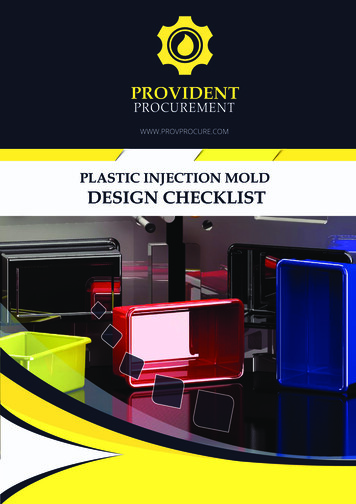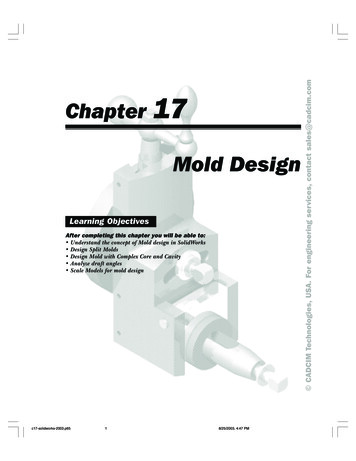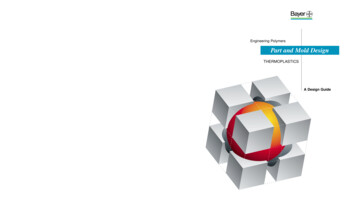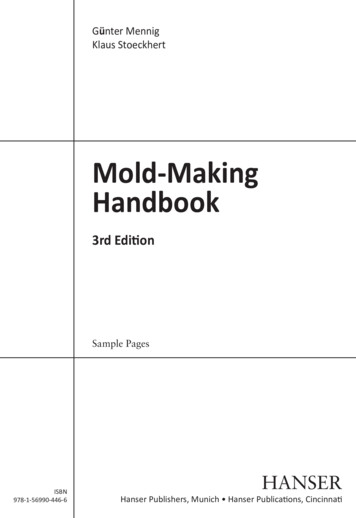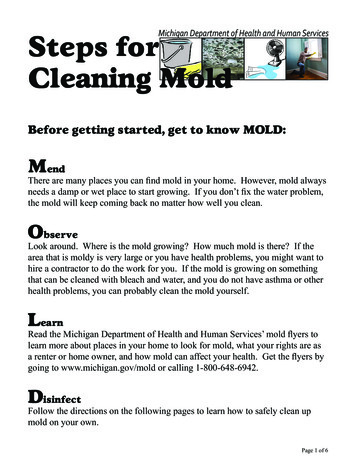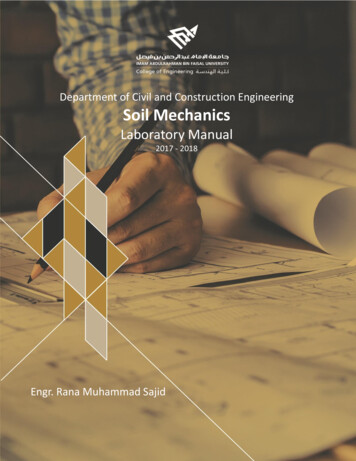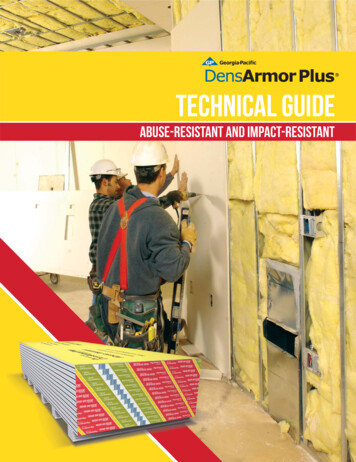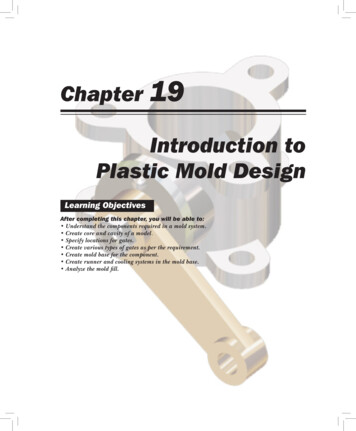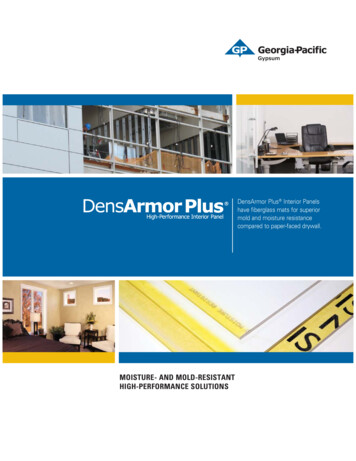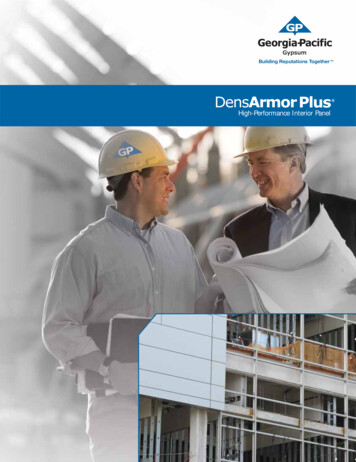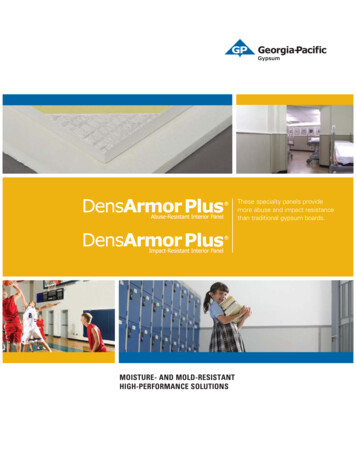
Transcription
These specialty panels providemore abuse and impact resistancethan traditional gypsum boards.MOISTURE- AND MOLD-RESISTANTHIGH-PERFORMANCE SOLUTIONS
DensArmor Plus Abuse-Resistant and Impact-Resistant PanelsProduct OverviewDensArmor Plus Abuse-Resistant Interior PanelDensArmor Plus Impact-Resistant Interior PanelCoated and EnhancedFiberglass MatsEmbedded MeshReinforcementCoated and EnhancedFiberglass MatsMoisture ResistantGypsum CoreDensArmor Plus Abuse-Resistant Interior Panels 2010 Georgia-Pacific Gypsum LLCMoisture ResistantGypsum CoreDensArmor Plus Impact-Resistant Interior Panels 2010 Georgia-Pacific Gypsum LLCLike DensArmor Plus High-Performance Interior Panels, DensArmor Plus Abuse-Resistant andImpact-Resistant Interior Panels have fiberglass mats for superior mold and moisture resistancecompared to paper-faced drywall. Fiberglass mats, instead of paper facings, eliminate a potential food source for mold growthand may reduce remediation and scheduling delays associated with paper-faced drywall Replaces traditional paper-faced abuse- and impact-resistant panels Used pre-rock, DensArmor Plus Abuse- and Impact-Resistant Panels stand up to ambientmoisture and incidental wettings during and after construction Backed with a 12-month weather exposure limited warranty against delamination,deterioration or decay. For complete warranty details, visit www.gpgypsum.com.Table of ContentsProduct Overview. . . . . . . . . . . . 2Abuse vs. Impact . . . . . . . . . . . . 4Enhanced ConstructionSchedule. . . . . . . . . . . . . . . . . . . 8Limited Warranty . . . . . . . . . . . . 9DensArmor Plus Abuse-Resistant and Impact-Resistant Panels are the first interior gypsumpanels to be GREENGUARD Indoor Air Quality Certified and GREENGUARD Children &SchoolsSM Certified for low emissions of volatile organic compounds (VOCs) by a leading thirdparty organization, GREENGUARD Environmental Institute. In addition, these panelsare the first and only interior panels listed as GREENGUARD microbial resistant. This listingmeans DensArmor Plus panels, which feature fiberglass mats instead of the paper facingsused on the surface of traditional gypsum board products, resist mold growth. The microbialresistant test is based on ASTM 6329, a testing standard set by ASTM International, whichdevelops testing guidelines and procedures for building materials, products, systems and services.Installation . . . . . . . . . . . . . . . . 11These panels also qualify for Collaborative for High Performance Schools (CHPS ) credits.CHPS is a national non-profit organization that works with school districts and their designteams to improve the quality of education by using products that have met requirements toreceive CHPS credits.Decorative Finishes . . . . . . . . . 11Areas of UseFire- and Sound-RatedAssemblies. . . . . . . . . . . . . . . . 13Interiors of exterior walls, where moisture intrusion is most likely.Pre-rock areas, where the windows, doors or roof have not been installed, makingmoisture intrusion inevitable.DensArmor Plus Abuse-Resistant Interior Panels are perfect for hallways, dorm and hospitalrooms and other high traffic areas where scuffing and abrasions may occur.Physical Properties. . . . . . . . . . 10Architectural Specifications. . . 15Limitations . . . . . . . . . . . . . . . . 18Commonly Used MetricConversions . . . . . . . . . . . . . . . 19DensArmor Plus Impact-Resistant Interior Panels, with an embedded mesh for the ultimateperformance, excel in ultra high traffic areas such as dorms and hospital corridors or secureareas such as correctional institutions.CAUTION: For product fire, safety and use information, go to gp.com/safetyinfo.2 For latest information and updates: Technical Service Hotline 1.800.225.6119 or www.gpgypsum.com
DensArmor Plus Abuse-Resistant and Impact-Resistant PanelsDensArmor Plus Abuse-Resistant and Impact-Resistant Panels feature fiberglass mats on both sides for superior moistureprotection. A revolutionary departure from traditional wallboard, the face of DensArmor Plus panels finishes in a similarmanner to traditional abuse- and impact-resistant gypsum boards and offers superior performance in resisting mold growth.For years, DensGlass Sheathing has been proven tough in commercial construction—under the most challenging weather conditions.Now the same powerful protection is working on the inside as DensArmor Plus Abuse-Resistant and Impact-Resistant Panels.Integrating DensArmor Plus panels into your specifications is part of an overall building solution that can help address themold issue and reduces the time and expense of replacing alternative products if they become wet.When tested, as manufactured, in accordance with ASTM D 3273, all DensArmor Plus interior panels scored a 10, the highestlevel of performance for mold resistance under the ASTM D 3273 test method. The score of 10, in the ASTM D 3273 test,indicates no mold growth in a 4-week controlled laboratory test. The mold resistance of any building product when used inactual job site conditions may not produce the same results as were achieved in the controlled, laboratory setting. No materialcan be considered mold proof. When properly used with good design, handling and construction practices, Dens Brand gypsumproducts provide increased mold resistance compared to standard paper-faced gypsum products.Georgia-Pacific Gypsum Products and LEED Many of our products may contribute to LEED credits. To find out more, please reference the Sustainable Materials DataSheets (SMDS) on our website (www.gpgypsum.com) for recycled content, regional materials, low emitting materials and otherpotential categories for LEED credit contributions.CAUTION: For product fire, safety and use information, go to gp.com/safetyinfo.For latest information and updates: Technical Service Hotline 1.800.225.6119 or www.gpgypsum.com 3
DensArmor Plus Abuse-Resistant and Impact-Resistant PanelsReduce Costly Remediation With Proven Fiberglass Mat TechnologyDensArmor Plus Abuse- and Impact-Resistant interior panels allowcontractors to hang them before dry-in. Paper-faced products areoften damaged by wind-driven rain and moisture during installation.DensArmor Plus panels stand up to normal weather conditions, whichallows for acceleration of schedules and the potential reduction ofcostly delays.All DensArmor Plus interior panels offer a 12-month weather exposurelimited warranty that guards against delamination and deteriorationwhen exposed to normal weather conditions during and after installation.It is very important at the beginning of the specification process tounderstand the types of abuse a singular structure must endure in dailyoperation, and in turn, specify the correct system for that application. A psychiatric hospital, designed to keep patients in, safe bythemselves, and separate from each other may require different type construction than an elementary school, concerned aboutscuffs and dents. Both structures require durable gypsum products, but the most appropriate material should be specified. Byunderstanding the short term requirements, long term money can be saved.What about an Abuse-Resistant System?An abuse-resistant system consists of a substrate that provides more abuse resistance than conventional gypsum panels. A plaster finish provides a monolithic surface and increased abrasion and impact resistance, achieving the highest qualityinterior panel finish. A primer-surfacer used in replacing a skim coat and paint primer can provide increased abrasion resistance. Abuse-resistant systems have been comprehensively tested for fire resistance and impact resistance. These ratings are onlyapplicable when all of the system components are used together. Substitutions of any of the components are not recommended and are not supported by Georgia-Pacific Gypsum. Always referto the appropriate product material safety data sheet for complete health and safety information.“High traffic” is a relative term when it comes to any building project. Any commercial, institutional or residential buildingcan include such a space. Regardless of the application, however, there are two types of potential damage that architects mustconsider when specifying a wall system for a high-traffic area:Abuse Resistance: Abrasion or scuffing of the walls due to high traffic of daily operations and indentation of the wallsurface. The occasional contact by humans, cleaning equipment and the gentle shoves of furniture. Generally used in hightraffic areas, abuse-resistant gypsum board reduces lifecycle cost by significantly increasing the time period betweenperiodic maintenance and improvement of the walls appearance. Abuse resistance is an important design considerationfor interior areas where a higher resistance to abrasion, indentation and impact penetration is required.Impact Resistance: Damage due to continuous impact or high energy that can tear into the stud cavity. Usingappropriate materials to resist damage not only contributes to long-term looks and appeal, but also decreases short termmaintenance costs of repairing the dents in the wall surface, and/or the possibility of intrusion into the inside of the wall.In response to this, the gypsum industry has developed specialized high-performance wall panels to provide architects withappropriate and cost-effective resistance to damage, while keeping design flexibility high. These materials, along with propersystems, have helped bridge the gap between design and strength.Abuse-Resistant vs. Impact-Resistant Interior PanelsThe markets for abuse-resistant and impact-resistant panels have grown over time. They are often placed together in onegypsum category by architects and those who specify material for a job. They are thought to be interchangeable. The truth isthey are separate product lines with different applications. Because of the activities taking place inside a facility, one mustspecify gypsum panels for specific applications.While abuse-resistant panels are now commonly used in hospitals, sometimes architects specify impact resistance for applicationswhere a less expensive abuse-resistant board will do the job. If there is a concern about incidental damage, such as things orpeople accidentally banging into the walls, then an abuse-resistant product is fine. The appropriate word is accident.If people are purposely trying to destroy walls, such as prison inmates or patients in psychiatric wards, then an impact-resistantpanel would be the best solution. The appropriate words are intentional impact.CAUTION: For product fire, safety and use information, go to gp.com/safetyinfo.4 For latest information and updates: Technical Service Hotline 1.800.225.6119 or www.gpgypsum.com
DensArmor Plus Abuse-Resistant and Impact-Resistant PanelsIndustry StandardsAnother way to understand the difference between penetration and surface damage is graphically. At the most basic level,abuse resistance can be defined as the ability of a partition system to resist two primary types of wall damage.Surface Damage: Abrasion and IndentationThis includes surface damage that can be caused by regular, ordinary contactwith people and furniture, as well as contact with various moving objects such asa medical gurney, vacuum cleaners, mail carts and other cleaning equipment.Penetration: Both Hard-Body and Soft-BodyHard-Body: hard objects, machinery, toolsSoft-Body: human or animalThe impact of penetration through the partition into the wall cavity, causingdamage that can be expensive to repair and in some instances dangerous.Applications and LevelsGeorgia-Pacific Gypsum has defined three separate levels of abuse resistance to help building owners and/or designprofessionals determine the type and amount of durability needed for specific building applications. Each category is describedbelow. Each category shown represents an improvement over standard interior drywall construction.LightDutyMild to ModerateDutyExtremeDutyFor areas requiring a basicupgrade to standard drywall,with improved resistanceto incidental surface andindentation damage.Incidental DamageSingle-family homesCafeterias/public areas in medical institutionsElementary school classrooms/stairwellsFor areas requiring a moderateresistance to incidental surfacedamage, indentation andpenetration, damage frompeople and objects.Middle/high school – classrooms, stairwellsCollege lecture hallsMulti-family stairways – common areasMailroomsShipping/receiving areasShopping centersUnintended DamageFor areas requiring resistanceto extreme levels of penetrationand/or surface indentation, anddamage from hard objects.Court detention facilitiesGovernment/military installationsAirportsSports facilitiesHospital corridorsGymnasiumsExtreme DamageTesting Methods—Significance and UseAbuse-resistant systems are tested to ensure long-term performance in real world applications. All Georgia-Pacific Gypsum productsand systems undergo exhaustive testing to ensure that they meet exacting standards. Independent products and systems are testedin accordance with ASTM standards. The American Society for Testing Materials (ASTM) established abuse- and impact-resistancestandards to measure the ability of gypsum panels to withstand surface abrasion, indentation and wall penetration.The standard ASTM C 1629, “Standard Classification for Abuse-Resistant, Non-Decorated Interior Gypsum Panel Products andFiber-Reinforced Cement Panels,” is the result of an industry initiative for testing method unification.Each abuse impact property of abuse-resistant wall panels is divided into three classification levels. The three levels ofclassification are: Level I, Level II and Level III.The test methods specified are utilized to establish the abuse-resistance classification of an abuse-resistant wall panel. Eachclassification level requires a minimum overall specified performance. Any classified abuse-resistant wall panel can be used at aclassification level which is rated lower than the highest level qualified.It is critical to understand the ASTM testing methods, as well as the optimal usage for various enhanced gypsum wallboards;this is integral to maximizing durability, design flexibility and long-term cost efficiency of high traffic and high use areas.CAUTION: For product fire, safety and use information, go to gp.com/safetyinfo.For latest information and updates: Technical Service Hotline 1.800.225.6119 or www.gpgypsum.com 5
DensArmor Plus Abuse-Resistant and Impact-Resistant PanelsPerformance Testing – Abuse-Resistance Testing MethodsSurface Damage, Abrasion Resistance Modified—ASTM D 4977This test method measures the ability of a gypsum panel surface to resist scratches andscuff marks by subjecting the panel to 50 back and forth cycles with a brush. This testwas intended for mineral-surfaced roofing products and was modified with additionalweight for a total of 25 lbs. (11 kg) to provide a suitable test of the abrasion resistanceof wall panel products. In this test, the sample material is placed under a movingweighted wire brush. The value reported for the test reflects the number of cycles towhich the partition can be exposed prior to failure. Failure is recorded as the depth ofabrasion after 50 cycles.Surface Abrasion(Modified ASTM D 4977)Interpreting Results: The board with the least amount of “rub” is the mostabrasion resistant.Surface Damage, Indentation Resistance—ASTM D 5420This test method, sometimes referred to in the industry as the “Gardner Impact Test 1,”was originally used to measure the impact resistance or toughness of plastic material.This test was modified to test gypsum panels in the same manner. This test measuresthe ability of a gypsum panel to resist dents from small hard objects. In this test, an 8 lb.(4 kg) weight is raised 9” (229 mm) above the material, then dropped onto a small 5/8”(15.9 mm) round die which hits the sample gypsum panel. The depth of the indentationis measured and recorded. The results are the average of three or more tests.Surface Indentation (ASTM D5420-Gardner Impact Test)Interpreting Results: The less penetration, the better.Penetration Soft-Body Impact Modified—ASTM E 695This test method covers the measurement of the relative resistance of wall, floor androof construction to impact loading. Sources of impact may include accidental impactfrom a human body due to pushing, shoving or falling; or moving heavy objects such asfurniture. Soft-body impact resistance testing uses a 60 lb. (27 kg) leather bag which ispulled away from the sample (in 6 inch (150 mm) increments) and released. The valuesreported represent the foot-pounds (joules) of energy required to produce failure ofthe partition.Single Drop Soft-Body Impact(Modified ASTM E 695)Interpreting Results: The higher the level recorded, the better the soft-bodyimpact performance.Penetration Hard-Body Impact ASTM C 1629—Annex A1This proposed test method is as follows: samples of drywall, 24” x 24” (610 x 610 mm),are mounted on 3-5/8” (92 mm) 20-gauge (30 mils) steel studs, 16” (406 mm) o.c.A 2-3/4” (70 mm) diameter steel ram is driven into the board surface. The weight isincreased until failure. A new panel is used for each impact. By increasing the weightof the ram, this increases the amount of impact energy which will impede the partitionassembly. This is measured in foot-pounds. Hard-body impact resistance testing uses aweighted ram which is pulled away from the sample and released. The value reportedis the maximum amount of impact force required to cause penetration into the partitioncavity with a single blow (defined as failure of the system).Interpreting Results: The higher the level, the greater the resistance tohard-body impact.CAUTION: For product fire, safety and use information, go to gp.com/safetyinfo.6 For latest information and updates: Technical Service Hotline 1.800.225.6119 or www.gpgypsum.comHard-Body Impact(ASTM C 1629 A1)
DensArmor Plus Abuse-Resistant and Impact-Resistant PanelsDensArmor Plus Abuse-Resistant Interior Panels Test Results—Single Layer—ASTM C 1629TestSurface AbrasionSurface DamageASTM D 4977Surface IndentationSurface DamageASTM D 5420Soft-Body ImpactPenetrationASTM E 695General Description of TestA wire brush is cycled across the boardsurface. Failure is recorded as the depthof abrasion after 50 cycles. The lower thenumber the better the abrasion resistance.An 8 lb. (3.6 kg) weight is raised 9 inches(229 mm), then dropped onto a small 5/8”(16 mm) round die which hits the sample.The value reported is the average of 3 ormore tests.A leather bag filled with 60 lbs. (27 kg) ofshot is released against the surface of theboard at increasing height until failure.Test Result Criteria1. 0.126” (3.2 mm)2. 0.059” (1.5 mm)3. 0.010” (.3 mm)Product Test ResultLevel 3Indentation Resistance1. 0.150” (3.8 mm)2. 0.100” (2.5 mm)3. 0.050” (1.3 mm)Level 1Soft Body1. 90 ft lbs (122 J)2. 195 ft lbs (265 J)3. 300 ft lbs (405 J)Level 1DensArmor Plus Impact-Resistant Interior Panels Test Results—Single Layer—ASTM C 1629TestSurface AbrasionSurface DamageASTM D 4977Soft-Body ImpactPenetrationASTM E 695General Description of TestA wire brush is cycled across the boardsurface. Failure is recorded as the depthof abrasion after 50 cycles. The lower thenumber the better the abrasion resistance.A 8 lb. (3.6 kg) weight is raised 9 inches(229 mm), then dropped onto a small 5/8”(15.9 mm) round die which hits the sample.The value reported is the average of 3 ormore tests.A leather bag filled with 60 lbs. (27 kg) ofshot is released against the surface of theboard at increasing height until failure.Hard-Body ImpactPenetrationASTM C 1629A 2-3/4” (70 mm) diameter steel ram isdriven into the board surface. Weight isincreased until failure.Surface IndentationSurface DamageASTM D 5420Test Result Criteria1. 0.126” (3.2 mm)2. 0.059” (1.5 mm)3. 0.010” (.3 mm)Product Test ResultLevel 3Indentation Resistance1. 0.150” (3.8 mm)2. 0.100” (2.5 mm)3. 0.050” (1.3 mm)Level 1Soft Body1. 90 ft lbs (122 J)2. 195 ft lbs (265 J)3. 300 ft lbs (405 J)Hard Body1. 50 ft lbs (68 J)2. 100 ft lbs (136 J)3. 150 ft lbs (204 J)Level 3Level 2DensArmor Plus Impact-Resistant Interior Panels Test Results—Double Layer—ASTM C 1629Base Layer: 5/8” (15.9 mm) DensArmor Plus Fireguard panel or 5/8” (15.9 mm) DensArmor Plus Impact-Resistant panel;Face Layer: DensArmor Plus Impact-Resistant panelTestSurface AbrasionSurface DamageASTM D 4977Soft-Body ImpactPenetrationASTM E 695General Description of TestA wire brush is cycled across the boardsurface. Failure is recorded as the depthof abrasion after 50 cycles. The lower thenumber the better the abrasion resistance.An 8 lb. (3.6 kg) weight is raised 9 inches(229 mm), then dropped onto a small 5/8”(15.9 mm) round die which hits the sample.The value reported is the average of 3 ormore tests.A leather bag filled with 60 lbs. (27 kg) ofshot is released against the surface of theboard at increasing height until failure.Hard-Body ImpactPenetrationASTM C 1629A 2-3/4” (70 mm) diameter steel ram isdriven into the board surface. Weight isincreased until failure.Surface IndentationSurface DamageASTM D 5420Test Result Criteria1. 0.126” (3.2 mm)2. 0.059” (1.5 mm)3. 0.010” (.3 mm)Product Test ResultLevel 3Indentation Resistance1. 0.150” (3.8 mm)2. 0.100” (2.5 mm)3. 0.050” (1.3 mm)Level 2Soft Body1. 90 ft lbs (122 J)2. 195 ft lbs (265 J)3. 300 ft lbs (405 J)Hard Body1. 50 ft lbs (68 J)2. 100 ft lbs (136 J)3. 150 ft lbs (204 J)Level 3Level 3CAUTION: For product fire, safety and use information, go to gp.com/safetyinfo.For latest information and updates: Technical Service Hotline 1.800.225.6119 or www.gpgypsum.com 7
DensArmor Plus Abuse-Resistant and Impact-Resistant PanelsEnhanced Construction ScheduleThe unique, moisture-resistant features of DensArmor Plus Abuse-Resistant and Impact-Resistant Panels allow builders toinstall gypsum assemblies when it’s not feasible to wait until cladding is completed. Georgia-Pacific Gypsum Dens Brandgypsum products offer weather exposure limited warranties against damage from exposure to normal weather conditions orhumidity if they are stored and installed according to instructions from the manufacturer. (See Page 9.)DensArmor Plus panels can potentially accelerate the construction process by up to 10 weeks. The potential savings in bothtime and money were a result of being able to install the gypsum panels earlier in the construction cycle before a structure isfully enclosed, allowing crews to work simultaneously and compressing schedules. All of our DensArmor Plus Interior Panels(High-Performance, Abuse-Resistant and Impact-Resistant) can be installed in this manner.By building from the inside out with these moisture-resistant gypsum products, general contractors potentially can completeprojects ahead of schedule, and building owners have an opportunity to generate faster cash flow by moving paying occupantsin more quickly. Not every project will realize such significant results and cost savings will vary by project.For more information on the value of using Georgia-Pacific Gypsum Dens Brand products in commercial construction, visitwww.gpgypsum.com.CAUTION: For product fire, safety and use information, go to gp.com/safetyinfo.8 For latest information and updates: Technical Service Hotline 1.800.225.6119 or www.gpgypsum.com
DensArmor Plus Abuse-Resistant and Impact-Resistant PanelsLimited WarrantyDensArmor Plus Abuse-Resistant and Impact-Resistant Panels are based on proven and patented Dens Brand gypsum products,which have a lengthy history of performance. Based on that track record, Georgia-Pacific Gypsum backs the performance ofDensArmor Plus panels with a limited warranty that includes:* 12 months of coverage against normal weather exposure (delamination, deterioration and decay). A three-year warranty against manufacturing defects.*For complete warranty details, visit www.gpgypsum.com.DensGlass SheathingFront of panelDensArmor Plus Interior PanelBack of panelCAUTION: For product fire, safety and use information, go to gp.com/safetyinfo.For latest information and updates: Technical Service Hotline 1.800.225.6119 or www.gpgypsum.com 9
DensArmor Plus Abuse-Resistant and Impact-Resistant PanelsPhysical PropertiesPropertiesDensArmor Plus Fireguard Abuse-Resistant PanelDensArmor Plus Fireguard Impact-Resistant PanelThickness, nominal5/8”(15.9 mm) 1/64”(0.4 mm)4’ (1219 mm) 3/32” (2.4 mm)8’ (2438 mm) to12’ (3658 mm) 1/4”(6.4 mm)2.81 (13.7)5/8”(15.9 mm) 1/64”(0.4 mm)4’ (1219mm) 3/32” (2.4 mm)8’ (2438 mm) to12’ (3658 mm) 1/4”(6.4 mm)2.81 (13.7) 10 (570) 100 (444) 140 (622).67 (0.118) 90 (400) 15 (67) 5% 1.6 grams 10 (570) 100 (444) 140 (622).67 (0.118) 90 (400) 15 (67) 5% 1.6 grams0/0 1/8” (3 mm)Noncombustible6.25 x 10-60/0 1/8” (3 mm)Noncombustible6.25 x 10-68.5 x 10-6 (15.3 x 10-6)8.5 x 10-6 (15.3 x 10-6)Width, standardLength, standardWeight1, lbs./sq. ft., nominal (kg m2)Permeance7 (Perms)[ng/Pa.s.m2]Flexural strength, parallel, lbf.3, 5 (N)Flexural strength, perpendicular, lbf.3, 5 (N)R Value2 (F ft2 hr/BTU)(k m2/w)Nail pull resistance minimum, lbf.3, 5 (N)Hardness core, edges and ends, lbf. (N)Water absorption (% of weight) 3, 4Surface water absorption3, 4Surface burning characteristics (per ASTM E 84 orCAN/ULC-S102): flame spread/smoke developedHumidified deflection, inchesCombustibility 6Linear expansion with moisture change in/in %RH(mm/mm/%RH)Coefficient of thermal expansion in/in/ F (mm/mm/ C)1Represents approximate weight for design and shipping purposes.Tested in accordance with ASTM C 518.3Tested in accordance with ASTM C 473.4Maximum requirements for ASTM C 630, ASTM C 1396 and ASTM C 1658.5Minimum requirements for ASTM C 1658 and ASTM C 1177.6As defined and tested in accordance with ASTM E 136.7Tested in accordance with ASTM E 96 (dry cup method).2NOTE: Specified minimum values are as in applicable ASTM C 1658, ASTM C 1177, ASTM C 1396 and ASTM C 630 standards.CAUTION: For product fire, safety and use information, go to gp.com/safetyinfo.10 For latest information and updates: Technical Service Hotline 1.800.225.6119 or www.gpgypsum.com
DensArmor Plus Abuse-Resistant and Impact-Resistant PanelsInstallationDensArmor Plus Abuse-Resistant and Impact-Resistant Interior Panels are installed in a similar manner to traditionalpaper-faced drywall. DensArmor Plus panels should be installed according to the most current versions of GypsumAssociation Publication GA-216 “Application and Finishing of Gypsum Panel Products” and ASTM C 840 “StandardSpecification for Application and Finishing of Gypsum Board for Non-Fire Rated Construction.” For best results, abutDensArmor Plus panels against regular paper-faced drywall only at inside or outside corners to eliminate transitions in thefield of a wall or ceiling. Adjust fastening tools to ensure that the fasteners are not over-driven through the face of the panel.Nails and screws should be driven with the heads slightly below the surface of the panel.1. DensArmor Plus Abuse- and Impact-Resistant panels shall be installed on a minimum of 20-gauge (30 mils) steel studs,16” (406 mm) o.c.2. For fire-rated installations, the installation and details shall be in conformity with those assemblies published in theGypsum Association Fire Resistance Design Manual GA-600, and UL and ULC Fire Resistance Directories.3. Nails shall be spaced a maximum of 8” (203 mm) on center on ceilings, and a maximum of 8” (203 mm) on center on walls.4. Nails shall be driven with the heads slightly below the surface of the gypsum board, avoiding damage to the face and coreof the board, such as breaking the fiberglass mat or fracturing the core.5. Screws shall be spaced not more than 12” (305 mm) on center along the framing members for ceilings and 16” (406 mm)on center for walls where the framing members are 16” (406 mm) on center. Screws shall be spaced not more than 12”(305 mm) on center along the framing members for ceilings and walls where framing members are 24” (610 mm) on center.6. When using a combination of fasteners consisting of nails along the perimeter and screws in the field of the gypsum board,the spacing between a nail and an adjacent screw shall be not more than the spacing specified for screws.7. Screws shall be driven to provide screw head penetration just below the DensArmor Plus panel surface without breaking thefiberglass mat surface of the panel or stripping the framing member around the screw shank.8. Suitable fascia and moulding shall be provided around the perimeter to protect the DensArmor Plus panels from directexposure to water. Unless protected by metal or other water stops, the edges of the DensArmor Plus boards shall be placednot less than 1/2” (13 mm) away from abutting vertical surfaces. Do not allow water to pond on DensArmor Plus panels.Decorative FinishesFinishingThe finishing and sanding of DensArmor Plus Interior Panels should be performed in accordance with the most current version ofGypsum Association Publication GA-214 “Recommended Levels of Gypsum Board Finish.” Joints between DensArmor Plus panelsmay be finished with either paper tape embedded with all-purpose joint compound or with fiberglass mesh tape and settingcompound. Because of the enhanced moisture- and mold-resistant properties of DensArmor Plus panels, drying times for thejoint and setting compounds may vary slightly. It is essential to allow each coat of compound to dry thoroughly before applyingadditional coats of compound. Care should be taken to ensure that all joints and fasteners are properly and adequately sanded toprovide a smooth transition between the compound and the face of the panel.Critical (Severe) Lighting Areas and Gloss PaintsWhen using gloss, semi-gloss or enamel paint, or when working in a critical (severe) lighting area, always finish DensArmorPlus panels to a Level 5 finish as detailed in GA-214. Critical lighting areas include but
DensArmor Plus Abuse-Resistant Interior Panels are perfect for hallways, dorm and hospital rooms and other high traffic areas where scuffing and abrasions may occur. DensArmor Plus Impact-Resistant Interior Panels, with an embedded mesh for the ultimate performance, excel in ultra high tra
